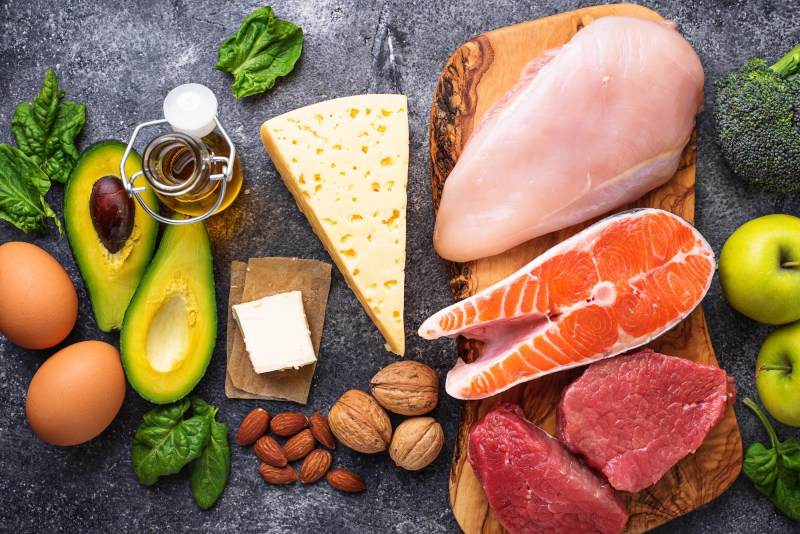Macronutrients have been a popular idea in the fitness and diet space since the 1990s. They’re the three primary groups that comprise most of our food: protein, carbohydrates, and fat. Macronutrients are vital because they give us the energy we need to get through our day and support various bodily functions.
But how can you calculate your intake of each macronutrient? And how do you know what your intake should be?
Learning how to calculate macros is not difficult. Keep reading for our complete guide, which includes the number of calories in each macro and how to track your food intake to monitor your macronutrients. Let’s get started!
What are macronutrients?

Macronutrients make up the majority of our food intake and calories. This contrasts with micronutrients, like vitamins and minerals, that we only need small amounts of. Each macronutrient is important for different reasons, and none should be cut entirely from your diet.
Protein
Protein might be the most essential macronutrient. Protein is made of amino acids, the building blocks for almost everything in your body. Everything from your muscles to your hair and skin is made from only 20 amino acids.
You often need more protein to repair and build your muscles when working out heavily. Meat, eggs, dairy, and fish are good protein sources, along with vegetables like tofu and legumes.
Carbohydrates
Carbohydrates get a bad rap, but they’re where your body gets most of its energy from. Fruits and vegetables are composed of carbohydrates, as well as rice and wheat.
Simple sugars are also carbohydrates. Many people think they need to cut out carbs because of processed starches and sugars, which are often unhealthy, but there are many sources of carbohydrates that are really good for you.
Fats
Fat has been maligned for a long time, but there are good and bad fats. Monounsaturated fats (like olive oil) and polyunsaturated fats (like most cooking oils) are healthy replacements for saturated fats (like bacon grease). Polyunsaturated fats also contain fatty acids, essential compounds for health. These can be found in fish, nuts, seeds, vegetable oils, and avocados.
How many calories are in each macro?

Carbohydrates and protein both contain four calories per gram, and fat has nine calories per gram. The FDA’s recommended daily intake for the average person is 50 grams of protein, 78 grams of fat, and 275 grams of carbohydrates.
That means (4 calories per gram x 50 grams of protein) 200 daily calories from protein, (9 calories per gram x 78 grams of fat) 702 daily calories from fat, and (4 calories per gram x 275 grams of carbohydrates) 1,100 calories from carbohydrates. This adds up to 2,000 calories if you eat exactly the recommended daily intake of all macronutrients, but it’s unlikely you’ll eat the exact quantities recommended daily. Also, many people who regularly exercise need at least double the protein intake the FDA recommends, so that number is debatable.
How do you know how many calories you should eat?

Adult men should consume between 2,200 and 3,000 calories per day, depending on their size and age. To lose weight, you usually need to take in fewer calories than your body uses, forcing your body to burn fat stores to make up the deficit. Counting calories isn’t the best strategy for everyone, but it can help many people figure out how much they need to eat to lose weight.
People who go through deliberate bulking and cutting phases must adjust their calorie intake accordingly, taking in more calories when bulking and fewer when cutting. A recommended calorie deficit is 200 to 500 fewer calories per day than your maintenance calories. Higher deficits of greater than 800 calories per day are not recommended, although studies are still looking into how much of a risk they are.
What is your ideal macro ratio?

The ideal macronutrient ratio can vary, depending on the individual. General recommendations are to get 20-35% of your calories from fat, 25-35% from protein, and 45-65% from carbohydrates. For example, you could aim for 25% fat, 25% protein, and 50% carbohydrates.
For weight loss, it’s usually best to aim for more protein and less fat and carbohydrates, something like 25% fat, 35% protein, and 45% carbohydrates. It might take some experimenting to find what works for you.
Tips for tracking your food intake
Keep a food journal
Keeping a food journal can be time-consuming, but it’s one of the simplest ways to track what you’re eating. Some people might not realize their snacking habits until they see it all written down. You can also see at a glance if one macro is missing or underrepresented in your diet.
Read nutrition labels
Reading the labels on your food will help you find out what kind of macros you’re getting. For example, a microwave meal of chicken and rice should consist mostly of protein and carbohydrates, but do you know how much fat is in a sauce it may include? The nutrition label will tell you.
Try a tracking app
Tracking apps are a great way to keep all your food information in one place. Some of the best food trackers include macronutrient information and calorie counts, so you don’t have to calculate it yourself!
Include everything
When tracking your food, it’s easy to grab a quick snack or a drink and decide it’s not worth the trouble of recording. But those little snacks can add up quickly, which might be the difference between a calorie deficit and a calorie surplus. Be sure to record everything.
When should you change your macro ratios?

You should change your macro ratios when you adjust your goals, like if you’re changing from bulking to cutting. You should also try new macro ratios if you feel like the ones you’re using aren’t working for you anymore, as your body weight, fat, or lean muscle mass has changed. If you notice your carbohydrate intake is weighing you down, or you can’t choke down one more chicken breast no matter how high-protein and low-fat it is, there’s no shame in trying a different route that is easier to be consistent with. A ratio you can stick to will be better in the long run.
Frequently asked questions

What are the benefits of calculating macros?
Calculating macros gives you a better idea of what food you’re eating and helps you keep track of the nutrition categories to ensure you’re getting a full and balanced plate. You can use macros to reach your fitness and weight loss goals, estimate your calorie intake, and get the necessary nutrients.
Who shouldn’t track their food intake?
Tracking your food and calculating macros can be stressful and time-consuming. If you find it too difficult to keep up with, or it’s causing you stress or anxiety about what you’re eating, you might want to stop tracking your food intake and just focus on intuitive eating.
Are certain macros better for weight loss than others?
Protein is the most impactful nutrient when it comes to weight loss. It is the most satiating macronutrient, and the body burns more calories just to digest protein than it does carbs or fats.




